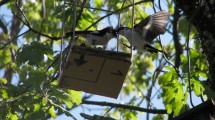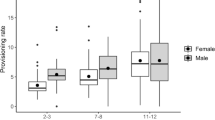Abstract
Several factors can influence the risk of cuckoldry through extra-pair paternity for male birds. The number of neighbouring males is thought to affect the chance of females engaging in extra-pair copulations, and species which breed both socially (colonially) and solitarily provide an ideal opportunity to test the effect of close proximity on extra-pair behaviour and paternity guards. In this study, the extent to which male house sparrows, Passer domesticus, used two alternative strategies, namely frequent copulation and mate-guarding, to ensure paternity was investigated. We also examined how males vary the two paternity guards according to their breeding sociality. Pairs at the dense colony started to copulate at a higher rate at the beginning of the fertile period than those of the medium-sized colony and solitary breeding pairs. Male house sparrows appear to fine-tune their strategies according to the breeding density. Both strategies are alternatively used in the weak fertile period but are simultaneously used in the peak fertile period. Our results suggest that males modify their strategy according to their individual abilities: mate-guarding intensity was positively correlated with the black breast badge size.


Similar content being viewed by others
References
Akçay E, Roughgarden J (2007) Extra-pair paternity in birds: review of the genetic benefits. Evol Ecol Res 9:855–868
Birkhead TR (1978) Behavioural adaptations to high density nesting in the common guillmot Uria aalge. Anim Behav 26:321–331
Birkhead TR (1982) Timing and duration of mate guarding in magpies, Pica pica. Anim Behav 30:277–283
Birkhead TR, Møller AP (1992a) Sperm competition in birds: evolutionary causes and consequences. Academic Press, London
Birkhead TR, Møller AP (1992b) Numbers and size of sperm storage tubules and the duration of sperm storage in birds: a comparative study. Biol J Linn Soc 45:363–372
Birkhead TR, Pellatt J, Hunter FM (1988) Extra-pair copulation and sperm competition in the zebra finch. Nature 334:60–62
Birkhead TR, Wishart GJ, Biggins JD (1995) Sperm precedence in the domestic fowl. Proc R Soc Lond B 261:285–292
Briskie JV (1990) Behavioural and anatomical correlates of sperm competition in birds. Ph.D. thesis, Queen’s University, Kingston, Canada
Colegrave N, Birkhead TR, Lessels CM (1995) Sperm precedence in zebra finches does not require special mechanisms of sperm competition. Proc R Soc Lond B 259:223–228
Dawkins R, Carlisle TR (1976) Parental investment, mate desertion and a fallacy. Nature 262:131–133
Gladstone DE (1979) Promiscuity in monogamous colonial birds. Am Nat 114:545–557
Gowaty PA, Buschhaus N (1998) Ultimate causation of aggressive and forced copulation in birds: female resistance, the CODE hypothesis, and social monogamy. Am Zool 38:207–225
Gowaty PA, Plissner JH (1987) Association of male and female American robins (Turdus migratorius) during the breeding season: paternity assurance by sexual access or mate-guarding? Wilson Bull 99:56–62
Griffith SC, Owens IPF, Burke T (1999) Female choice and annual reproductive success favour less-ornamented male house sparrows. Proc R Soc Lond B 266:765–770
Griffith SC, Owens IPF, Thuman KA (2002) Extra pair paternity in birds: a review of interspecific variation and adaptive function. Mol Ecol 11:2195–2212
Griggio M, Venuto G (2007) The relationship between mate guarding and brood desertion in the rock sparrow Petronia petronia. Ethol Ecol Evol 19:175–182
Griggio M, Matessi G, Pilastro A (2005) Should I stay or should I go? Female brood desertion and male counterstrategy in rock sparrows. Behav Ecol 16:435–441
Hasselquist D, Bensch S (1991) Trade-off between mate guarding and mate attraction in the polygynous great reed warbler. Behav Ecol Sociobiol 28:187–193
Hatchwell BJ, Davies NB (1992) An experimental study of mating competition in monogamous and polyandrous dunnocks Prunella modularis. I. Mate-guarding and copulations. Anim Behav 43:595–609
Jennions MD, Petrie M (2000) Why do females mate multiply? A review of the genetic benefits. Biol Rev Camb Philos Soc 75:21–64
Kempenaers B, Verheyen GR, Van den Broeck M, Burke T, Van Broeckhoven C, Dhondt AA (1992) Extra-pair paternity results from female preference for high quality males in the blue tit. Nature 357:494–496
Lamprecht J (1989) Mate guarding in geese: awaiting female receptivity, protection of paternity or support of female feeding? In: Rasa AE, Vogel C, Voland E (eds) The sociobiology of sexual and reproductive strategies. Chapman & Hall, London, pp 48–60
Lifjeld JT, Marstein B (1994) Paternity assurance behaviour in the House Martin Delichon urbica. J Avian Biol 25:231–238
Møller AP (1985) Mixed reproductive strategies and mate guarding in a semi-colonial passerine, the swallow Hirundo rustica. Behav Ecol Sociobiol 17:401–408
Møller AP (1987a) Advantages and disadvantages of coloniality in the swallow Hirundo rustica. Anim Behav 35:819–832
Møller AP (1987b) Variation in badge size in male house sparrows Passer domesticus: evidence for status signalling. Anim Behav 35:1637–1644
Møller AP (1987c) House sparrow, Passer domesticus, communal displays. Anim Behav 35:203–210
Møller AP (1990) Sexual behaviour is related to badge size in the house sparrow Passer domesticus. Behav Ecol Sociobiol 27:23–29
Møller AP, Birkhead TR (1991) Frequent copulations and mate guarding as alternative paternity guards in birds: a comparative study. Behaviour 118:170–186
Møller AP, Birkhead TR (1993) Certainty of paternity covaries with paternal care in birds. Behav Ecol Sociobiol 33:261–268
Moreno-Rueda G (2005) Sexual size dimorphism and assortative mating for morphological traits in Passer domesticus. J Ethol 24:227–230
Mougeot F (2004) Breeding density, cuckoldry risk and copulation behaviour during the fertile period in raptors: a comparative analysis. Anim Behav 67:1067–1076
Nakagawa S, Ockendon N, Gillespie DOS, Hatchwell BJ, Burke T (2007) Assessing the function of house sparrows’ bib size using a flexible meta-analysis method. Behav Ecol 18:831–840
Norušis MJ (1993) SPSS for windows: Base system user’s guide, release 6.0. SPSS, Chicago
Pilastro A, Griggio M, Biddau L, Mingozzi T (2002) Extrapair paternity as a cost of polygyny in the rock sparrow: behavioural and genetic evidence of the “trade-off” hypothesis. Anim Behav 63:967–974
Pinxten R, van Elsacker L, Verheyen RF (1987) Duration and pattern of mate guarding in the starling. Ardea 75:263–269
Sheldon BC (1994) Timing and use of paternity guards by male chaffinches. Behaviour 129:79–97
Sherman PW, Morton ML (1988) Extra pair fertilizations in mountain white-crowned sparrows. Behav Ecol Sociobiol 22:413–420
Summers-Smith D (1954) The communal display of the house sparrow Passer domesticus. Ibis 96:116–128
Svensson L (1992) Identification guide to European passerines. British Trust for Ornithology, Thetford
Václav R, Hoi H (2002) Importance of colony size and breeding synchrony on behaviour, reproductive success and paternity in house sparrow Passer domesticus. Folia Zool 51:35–48
Václav R, Hoi H, Blomqvist D (2002) Badge size, paternity assurance behaviours and paternity losses in male house sparrow. J Avian Biol 33:314–318
Veiga JP, Puerta P (1996) Nutritional constraints determine the expression of a sexual trait in the house sparrow, Passer domesticus. Proc R Soc Lond B 263:229–234
Westneat DF, Stewart IRK (2003) Extra-pair paternity in birds: causes, correlates, and conflict. Annu Rev Ecol Evol Syst 34:365–396
Wetton JH, Parkin DT (1991) An association between fertility and cuckoldry in the house sparrow Passer domesticus. Proc R Soc Lond B 245:227–232
Wittenberger JC, Hunt GL Jr (1985) The adaptive significance of coloniality in birds. In: Farner DS, King JR, Parkes KC (eds) Avian biology, vol 8. Academic Press, Orlando, pp 2–78
Acknowledgments
We thank Uwe Römer for assistance in the field. This study was supported by a grant from Österreichische Fonds zur Förderung der Wissenschaftlichen Forschung (No. FWF 19310-B17).
Author information
Authors and Affiliations
Corresponding author
About this article
Cite this article
Hoi, H., Tost, H. & Griggio, M. The effect of breeding density and male quality on paternity-assurance behaviours in the house sparrow, Passer domesticus . J Ethol 29, 31–38 (2011). https://doi.org/10.1007/s10164-010-0217-1
Received:
Accepted:
Published:
Issue Date:
DOI: https://doi.org/10.1007/s10164-010-0217-1




